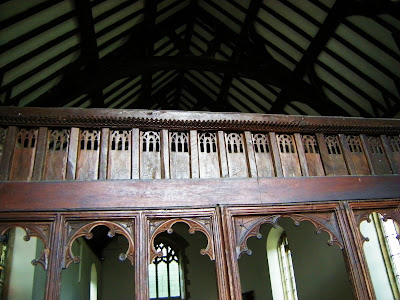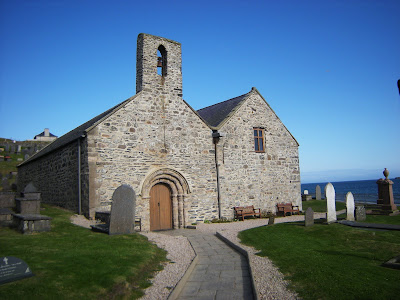





























17th August 2009
We left Chirk after another excellent breakfast (mine somewhat small because of the diet) and drove of towards Bala. I did want to call in on Gwyddelwern. This was said to be a settlement of St Beuno . It proved to be a challenge for the satnav, but we did find it-and it was locked-even the gate into the church was locked, so it was a dead loss. We drove half a mile north of the village to find the well, but this proved to be elusive. We thought we had found it, but in the height of the summer it was possible that the well had dried up.
Llanderfyl
We found a stream but not a well and so that was unsuccessful.We drove down to Bala, passing through Llanderfyl. Now we have a Llanderfyl in Cwmbran, where Arthrwys’s soldier friend had become a hermit and established a small community. I was eager to see a surviving relic of the reformation- the stag upon which St Derfyl had ridden on his memorial statue in the church. St Derfyl could have been the patron saint of vets.
He was brilliant at curing animals particularly from their ailments. There was reputedly a statue at Cwmbran as well. Both statues, like that of Our Lady of Penrhys were quite wickedly dragged off to England to be burned at Smithfield. The legend of St Derfyl said, that one day if it were ever destroyed a whole forest would be set on fire. It suited the rather wicked people at that time, that to burn poor Father Forrest on the pyre of these wooden statues was funny. The stag remained in the church. One vicar tried to wreck it, and it remained in the chancel for many years. Now it is out in the porch. Masses and Divine Office was once said and sung here. I said another Rosary , after photographing the remains of the stag and other artefacts and after locking up the church, returned the key to the old peoples home from whence it had come.
Stop off at Portmeirion
Bala and Llyn Tegid were a poem in the Autumn sunshine. Wonderful colours and scenery as we drove further into the Snowdonia National Park arriving at Portmeirion in the early afternoon. This was a most interesting place for the family, including a swimming pool and hundreds of different Italian styled architectural exhibits. Some of them were hotel rooms, others just shells, with nothing inside, a fad of Clough Williams Ellis. We spent about two hours looking around and managed to find some food there too. It really was like walking into Italy or Spain-such a load of colour. Bookshops, paddling pools for little children ,a swimming pool, dog cemetery and the all important ‘Prisoner Shop’ as ‘The Prisoner ‘ with Patrick Magoohan was filmed here in the 1960s. I bought a couple of books after a long walk. A children’s book about St David and ‘What Welsh Plae Names Mean’ and ‘Wales before 1530’ which proved very interesting indeed.
Lleyn Peninsula to Aberdaron
Driving off again we started the long journey down the Lleyn peninsula to Aberdaron. My son leapt with joy at seeing the sea just over the road and ran off to leap into the sea with great abandon. He returned very cold when it was almost dark. We loved our room in the comfortable pilgrims pub ‘The Ship’ although we ate in the Gwest opposite. I walked into St Hwyn’s Church which was the pilgrim’s church and where people would say Mass before leaving for Bardsey Island, the holy mystical island at the end of the journey.
There has been a place of Christian worship at the edge of the sea at Aberdaron since the fifth century. At first a simple wooden structure housed both Hywyn and his prayer cell where the Gospel was preached to the few villagers whose humble cottages clung to the side of the cliffs and whose livelihood depended on the sea and the few acres of soil in which they grew crops.
Cadfan, the warrior saint, who travelled from Brittany with Hywyn, moved on to Enlli, the island off the tip of the Llŷn peninsula. There he set up a religious house, later to be dedicated to St Mary. To both men these were places of their resurrection. Places where they felt God had called them to live, to pray and to die.
The title 'saint' in the early Catholic Church was often by acclamation of the people before the Congregation ofSaints was set up in the Twelfth century.The Bishop of Hereford created St Issui saint, and so such holy men were aclaimed by bishops locally.
Griffudd (Griffith)ap Cynan
In 1137, Gruffydd ap Cynan, King of Gwynedd, began erecting stone churches to replace the wooden buildings in the most important parishes and so the oldest portion of St Hywyn's Church dates from this time. It became a sanctuary church within which, on the stone chair called the chair of peace, disputes could be settled and no fugitive could be ejected for 40 days and nights.
St Hywyn's Church was also a clas church, similar to a monastic settlement but without affiliation to a particular rule -an association of clergy working together and leading a common life under the authority of a chosen leader or Abbot. The clas was maintained long after the Normans set out to break up such organised structures and was followed by a portionary church - a network of benefices held by individuals, usually following a family tradition - without corporate ties. The revenues were divided into portions among the clergy in charge of the area.
In 1417, the church at Aberdaron was enlarged. Records show that it was still closely connected with St Mary's Abbey on Bardsey.
When Henry VIII broke from the Church in 1536, the monasteries were closed and for a short while the Diocese of Bangor benefitted from a revitalised church served by devout priests, but gradually decline set in and sinecure rectors with no parish duties to perform were in charge and paid vicars to take on the duties of parish priest.
St John's College Cambidge vicar struggles to speakWelsh
In 1624, St John's College, Cambridge became the patron of the parish and remained so for almost 300 years. The Rectors in the 17th & 18th centuries seem to have been instituted by the Bishop of Bangor and 'read themselves in' by the saying of Matins. Rowland Simpson was required to take services in Welsh even though he did not speak the language, those before him taking the services in English.
Bardsey Island-The Holy Island of 20,000 Saints!
Aberdaron is the starting point for Bardsey Island.
Saints Cadfan and St Hwyn came to found a llan on the island, after hermits had been there for sometime. In Norman times, St Mary’s Abbey came into being and its ruins can still be seen. I was thrilled to be coming to go to the island, the highlight of the pilgrimage and I managed to buy in the bookstall a copy of ‘Monks of Ynys Enlli’ and ‘Monks of Ynys Enlli II’ (being Normans and beyond) The pilgrim church of St Hywyn had originally been a single chambered church with few windows as you would expect so near the sea, which was literally outside.I was also interested to note that RS Thomas, the wonderful poet had been vicar there for part of his life.
Disappointment
I went back to the hotel and we went to sleep getting up early for the trip to Bardsey Island. At last I was going to step on to the Island of 20,000 saints, where St Madryn had built her church. (This was St Materiana of Gwent and Cornwall), Where Dyfrig (St Dubricius)had died and been buried before his relics were brought back to Llandaff. I was looking forward to stepping on the holy island.
Tuesday 18th August 2009
Alarm at 8 and then we dressed in our warmest clothes as there was a strong wind blowing and a hint of rain in the air. Ian and Christian went off to the car and I went with them and then Ian rang the boatman on the payphone (as there was no mobile reception!) To my tremendous disappointment (and no one who knows how much I had looked forward to treading on that island can doubt how disappointed I was) There was no prospect of any sailing for a few days because of forecasts of strong winds. I fought to hide my disappointment. I know the others knew how it was and they were anxious to help. Instead, we decided to do the pilgrims route in reverse and visit two sites on the way to Caernarfon, where pilgrims would stop on their way to Bardsey. A trip around Caernarfon Castle was included for fun at the end.
More later frm the pilgrimage¬!






















































































No comments:
Post a Comment